In the garment business, accuracy and communication are everything. A single misstep in fabric choice can disrupt an entire production run. That is why swatch cards are at the center of fabric merchandising. They act as tangible guides for color, material, and quality.
Understanding what a swatch card is and how it functions can help buyers, designers, and manufacturers work with confidence, accuracy, and speed.
A Swatch Card as a Color Reference
Color accuracy is a constant challenge in garment production. Swatch cards present a standardized reference for fabric shades. This helps maintain consistency across multiple production runs and vendors.
Designers rely on them to align creative direction with manufacturing. Buyers use them to confirm fabric shades before bulk orders. Without swatch cards, color discrepancies can lead to wasted material and costly delays.
Texture and Material Assessment
One cannot judge fabric quality by photographs alone. Texture, thickness, and drape are best understood through touch. Swatch cards carry small but true samples of fabric, making evaluation easier.
Manufacturers can gauge if the fabric aligns with design requirements. Retail buyers can test feel and appearance against current market preferences. By placing the actual fabric in hand, swatch cards support accurate decision-making in material selection.
Quality Control and Standards
Maintaining quality standards is one of the most challenging aspects of garment production. Swatch cards allow production teams to match bulk fabric deliveries with approved samples. They act as benchmarks for quality and consistency.
If there are deviations, teams can detect them early. This role reduces costly errors and preserves quality at scale. The presence of swatch cards supports accountability across supply chains.
Communication Across Teams
The garment business brings together many stakeholders, from mills to designers to retailers. Communication breakdowns can easily occur. Swatch cards serve as a shared reference point. They eliminate guesswork by showing the exact fabric sample rather than relying on descriptions.
Designers use them to pitch ideas. Production teams use them to clarify specifications. Buyers use them to review options. This shared language reduces mistakes and builds trust across the supply chain.
Ordering and Reordering Accuracy
Ordering fabric can be complex, especially with multiple shades, weights, and finishes available. Swatch cards simplify this by giving suppliers a physical reference. When placing orders, teams can match fabric precisely to the card.
For reorders, swatch cards serve as reliable archives. They prevent mismatches between past and present fabric deliveries. This accuracy saves time, supports consistent branding, and reduces the risk of waste in large runs.
Cost Planning and Budgeting
Fabric decisions influence the overall cost of garment production. Swatch cards help estimate fabric requirements for specific designs. By referencing swatches early, teams can calculate how much material a garment needs and set accurate budgets.
This practical use supports both financial planning and production timelines. Cost accuracy is not just about saving money, it helps businesses stay competitive in a fast-moving market.
Archiving and Long-Term Records
Collections evolve season after season, but designers often revisit past ideas. Swatch cards create a record of fabrics used in previous lines. These archives make it easier to replicate or revisit past styles.
For some businesses, maintaining a library of swatch cards also strengthens brand identity. Having a physical record of textures and colors creates continuity in design history.
Prototyping and Sample Development
Before full-scale production, garment prototypes require accurate materials. Swatch cards serve as the source for these trial fabrics. Designers can work with the exact fabric intended for final production, aligning expectations from concept to completion. This step reduces risks during prototyping and builds confidence in the production plan.
Client Presentations and Merchandising
Designers and merchandisers use swatch cards in presentations to showcase fabric options. These cards allow clients to touch and see the fabrics, rather than only viewing images. The physical element builds confidence and supports decision-making.
In competitive presentations, swatch cards often influence client approval. They also highlight professionalism by showing preparedness and attention to detail.
How Swatch Cards Compare to Sample Books
While swatch cards are efficient and cost-friendly, sample books serve a different role. Sample books allow for larger fabric displays, often including multiple options in one place. They are useful but labor-intensive. Swatch cards, on the other hand, are faster to produce and easier to distribute. They balance production efficiency with communication needs, making them a preferred tool in many garment businesses.
Discover More About Swatch Cards
Businesses that want to improve communication and speed often turn to swatch cards. Their adaptability makes them practical for both small runs and large-scale production. For many, swatch cards are not just tools but strategic assets in a competitive market.
Partner With Harris Sample Book for Your Next Project
Here at Harris Sample Book, we have spent decades helping customers share their fabrics through swatch cards and memo samples. Our team focuses on quality, communication, and dependable timelines.
By working closely with you, we make sure your sampling program reflects the accuracy and professionalism your brand needs.

